Canon FS405, FS 46, FS406 User Manual
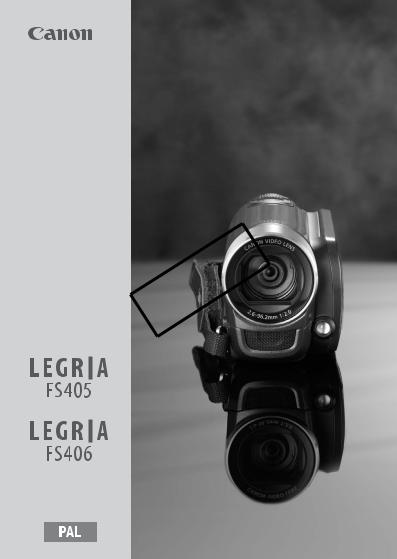
PUB. DIE-0382-000
Digital Camcorder
Instruction Manual





 COPY
COPY

Important Usage Instructions
WARNING!
TO REDUCE THE RISK OF ELECTRIC SHOCK, DO NOT REMOVE COVER (OR BACK). NO USER SERVICEABLE PARTS INSIDE. REFER SERVICING TO QUALIFIED SERVICE PERSONNEL.
WARNING!
TO REDUCE THE RISK OF FIRE OR ELECTRIC SHOCK, DO NOT EXPOSE THIS PRODUCT TO RAIN OR MOISTURE.
COPYRIGHT WARNING:
Unauthorized recording of copyrighted materials may infringe on the rights of copyright owners and be contrary to copyright laws.
CAUTION:
TO REDUCE THE RISK OF ELECTRIC SHOCK AND TO REDUCE ANNOYING INTERFERENCE, USE THE RECOMMENDED ACCESSORIES ONLY.
CAUTION:
DISCONNECT THE MAINS PLUG FROM THE SUP LY SOCKET WHEN NOT IN USE.
To reduce the risk of electric shock, do not expose this product to dripping or splashing.
The Mains plug is used as the disconnect device. The Mains plug shall remain readily operable to disconnect the plug in case of an accident.
COPY
While using the compact power adapter, do not wrap it or cover it with a piece of cloth, and do not place it in confined narrow spaces. Heat may build up, the plastic case may deform and it could result in electric shock or fire.
CA-570E identification plate is located on the bottom.
Using any device other than the Compact Power Adapter CA-570E may damage the camcorder.
2
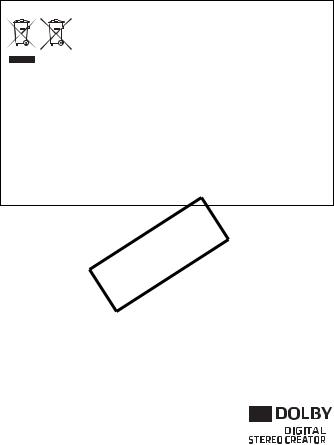
European Union (and EEA) only.
These symbols indicate that this product is not to be disposed of with your household waste, according to the WEEE Directive (2002/
96/EC), the Battery Directive (2006/66/EC) and/or your national laws implementing those Directives.
This product should be handed over to a designated collection point, e.g., on an authorized one-for-one basis when you buy a new similar product or to an authorized collection site for recycling waste electrical and electronic equipment (EEE) and batteries and accumulators. Improper handling of this type of waste could have a possible impact on the environment and human health due to potentially hazardous substances that are generally associated with EEE. Your cooperation in the correct disposal of this product will contribute to the effective usage of natural resources.
For more information about the recycling of this product, please contact your local city office, waste authority, approved scheme or your household waste disposal service or visit www.canon-europe.com/environment.
(EEA: Norway, Iceland and Liechtenstein)
COPY
Trademark Acknowledgements
•SD, SDHC and SDXC Logos are trademarks of SD-3C, LLC.
•Microsoft and Windows are trademarks or registered trademarks of Microsoft Corporation in the United States and/or other countries.
•Macintosh and Mac OS are trademarks of Apple Inc., registered in the U.S. and other countries.
•Manufactured under license from Dolby Laboratories.
“Dolby” and the double-D symbol are trademarks of Dolby Laboratories.
•Other names and products not mentioned above may be trademarks or registered trademarks of their respective companies.
•This device incorporates exFAT technology licensed from Microsoft.
•ANY USE OF THIS PRODUCT OTHER THAN CONSUMER PERSONAL USE IN
ANY MANNER THAT COMPLIES WITH THE MPEG-2 STANDARD FOR ENCODING VIDEO INFORMATION FOR PACKAGED MEDIA IS EXPRESSLY PROHIBITED WITHOUT A LICENSE UNDER APPLICABLE PATENTS IN THE MPEG-2 PATENT PORTFOLIO, WHICH LICENSE IS AVAILABLE FROM MPEG LA, L.L.C., 250 STEELE STREET, SUITE 300, DENVER, COLORADO 80206.
3
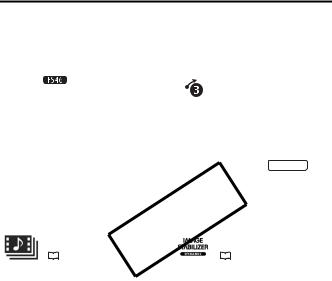
Exciting Features
Whether you are using a camcorder for the first time or are very experienced, this camcorder offers many easy-to-use functions. The following are just but a few examples of the many functions that can enrich your shooting experience.
 Dual Flash Memory
Dual Flash Memory
You can record in the built-in memory or on commercially available memory cards ( 31).
31).
Pre-recording
( 50)
50)
When pre-recording is activated, the camcorder starts recording video continuously into a temporary 3-second memory. When you press the Start/Stop button, the scene recorded will have started 3 seconds before
|
|
|
COPY |
||||
|
|
|
|
|
you started shooting. |
||
Video Snapshot |
|
Image Stabilization |
|||||
( |
|
51) |
|
( |
|
50) |
|
|
|
|
|||||
Shoot or capture short scenes |
|
Dynamic IS compensates for |
|||||
and arrange them into a video |
|
camcorder shake when you |
|||||
clip set to your favorite |
|
|
shoot video while walking. This |
||||
background music. |
|
|
gives you more freedom and |
||||
|
|
|
|
|
mobility when recording movies. |
||
|
|
|
|
|
|
|
|
4
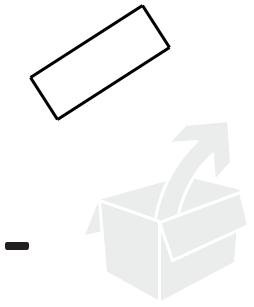
Table of contents
Introduction
4 Exciting Features
8About this Manual
10Getting to Know the Camcorder
10Supplied Accessories and CD-ROMs
12Names of Parts
Preparations
15Getting Started
15 Charging the Battery Pack
18PreparingCOPYthe Accessories
19Adjusting the Position and Brightness of the LCD Screen23 Using the Menus
26 First Time Settings
26Setting the Date and Time
27Changing the Language
27Changing the Time Zone
28Using a Memory Card
28Memory Cards Compatible for Use with the Camcorder
30Inserting and Removing a Memory Card
31 Selecting the Memory for the Recordings
Selecting the Memory for the Recordings
31Initializing the Memory
Table of contents 5
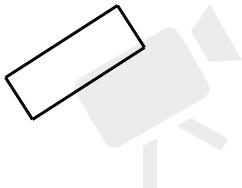
Video
34Basic Recording
34Shooting Video
35Selecting the Video Quality (Recording Mode)
36Zooming: Optical, Advanced and Digital Zoom
37Quick Start Function
39 Basic Playback
39 Playing Back Video
41Selecting what Recordings to Play Back
42Searching for Scenes
44Pre-selecting Recordings from the Index Screen
45Deleting Scenes
47 Advanced Functions
47 Automatic Exposure and Special Scene Recording
Programs
49Automatic Backlight Correction
50Advanced Image Stabilization
50Pre-RecordingCOPY
51Video Snapshot
52Digital Effects
53Manual Exposure Adjustment
54Manual Focus Adjustment
55White Balance
56Image Effects
57Mini Video Light
57Self Timer
58Selecting the Playback Starting Point
59Playing Back Recordings Set to Background Music
62On-Screen Displays and Data Code
63 Playlist and Scene Operations
63 Editing the Playlist: Adding, Deleting and Moving
Scenes
65Dividing Scenes
66 Copying Scenes to a Memory Card
Copying Scenes to a Memory Card
6 Table of contents
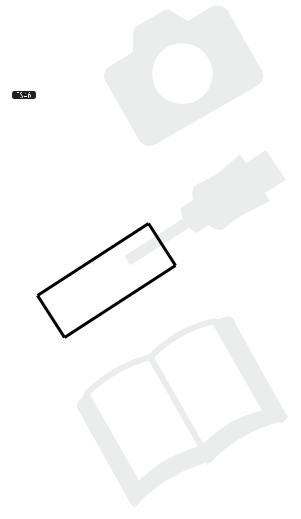
Photos
69Taking Photos
70Viewing Photos
72 |
Slideshow |
72 |
Deleting Photos |
74Copying Photos to a Memory Card
External Connections
76Terminals on the Camcorder
76 Connection Diagrams
78Playback on a TV Screen
79Saving and Sharing Your Recordings
79Saving Recordings on a Computer
81Copying Movies to an External Video Recorder
82Preparing Movies for the Web
Additional InformationCOPY
98 Trouble?
98 |
Troubleshooting |
103 |
List of Messages |
109 Do’s and Don’ts
109 Handling Precautions
113Maintenance/Others
114Using the Camcorder Abroad
115General Information
115Accessories
116Optional Accessories
119 |
Specifications |
123 |
Index |
Table of contents 7
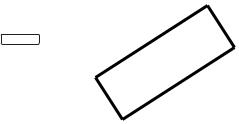
About this Manual
Thank you for purchasing the Canon LEGRIA FS46 / LEGRIA FS405 / LEGRIA FS406. Please read this manual carefully before you use the camcorder and retain it for future reference. Should your camcorder fail to operate correctly, refer to Troubleshooting (  98).
98).
Conventions Used in this Manual
• IMPORTANT: Precautions related to the camcorder’s operation.
IMPORTANT: Precautions related to the camcorder’s operation.
• NOTES: Additional topics that complement the basic operating procedures.
NOTES: Additional topics that complement the basic operating procedures.
• POINTS TO CHECK: Restrictions or requirements regarding the function described.
POINTS TO CHECK: Restrictions or requirements regarding the function described.
• : Reference page number within this manual.
: Reference page number within this manual.
• : Text that applies only to the model shown in the icon.
: Text that applies only to the model shown in the icon.
•The following terms are used in this manual:
When not specified as “memory card” or “built-in memory”, the term “memory” by itself refers to both.
“Scene” refers to one movie unit from the point you press the
•The photos included inCOPYthis manual are simulated pictures taken with a still camera. Unless indicated otherwise, illustrations and menu icons refer to the  . pause
. pause
8 Introduction
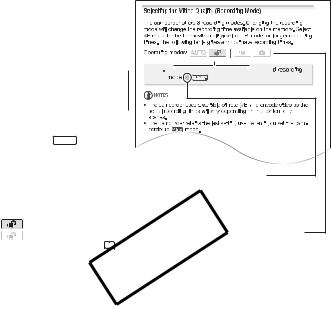
Brackets [ ] are used to refer to  menu options as they are
menu options as they are 

















displayed on screen.
The names of most buttons and  switches are indicated within a “button” frame.
switches are indicated within a “button” frame.
For example FUNC. .
The  arrow is used to abbreviate menu selections. For a detailed explanation on how to use the menus, refer to Using the Menus
arrow is used to abbreviate menu selections. For a detailed explanation on how to use the menus, refer to Using the Menus
(  23). For a concise summary of all available menu options and settings, refer to the appendix Menu Options Lists (
23). For a concise summary of all available menu options and settings, refer to the appendix Menu Options Lists ( 86).
86).
|
COPY |
|||
|
indicates that a function is available in the operating mode indicated and |
|||
|
indicates that the function is not available. For a detailed explanation |
|||
refer to Operating Modes ( |
|
|
21). |
|
|
|
|||
|
|
|
|
|
Introduction 9
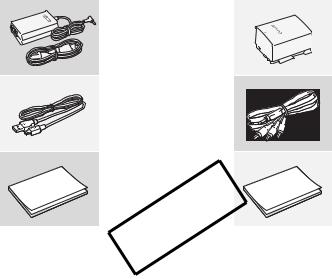
Supplied Accessories and CD-ROMs
The following accessories are supplied with the camcorder:
XCA-570E Compact Power Adapter
(incl. power cord)
BP-808 Battery PackW
XIFC-300PCU/S USB Cable
STV-250N Stereo Video CableW
Yellow • Red • White plugs
XQuick Guide
COPYInstallation Guide for IXELA’sW
Software
10 Introduction
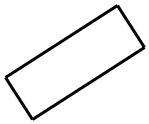
The following CD-ROMs and software are supplied with the camcorder:
•PIXELA’s Transfer Utility CD-ROM*
-Use Transfer Utility for saving and transferring movies and music files you can use as background music.
• /
/ PIXELA’s VideoBrowser CD-ROM*
PIXELA’s VideoBrowser CD-ROM*
-In addition to all the functionality of Transfer Utility, you can use VideoBrowser for managing, editing, and playing back movies.
• Instruction Manual/Music Data CD-ROM (referred to in this manual as “Camcorder Supplemental Disc”)
Instruction Manual/Music Data CD-ROM (referred to in this manual as “Camcorder Supplemental Disc”)
-Instruction Manual - The full-version instruction manual of the camcorder (this PDF file).
-Music data - Music files that can be used as background music during playback. These music files are for exclusive use with the supplied PIXELA’s software. The disc cannot be played back on CD players.
* The CD-ROM includes the instruction manual of the software (on PDF file).
COPY
Introduction 11
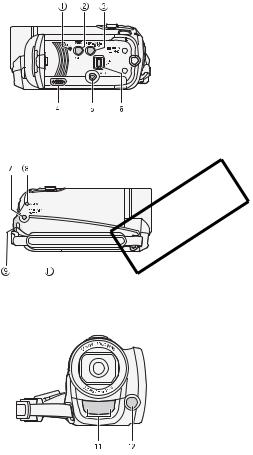
Names of Parts
Left side view
Right side view
1 RESET button ( 102)
102)
2  button (
button ( 21)/ WEB button (
21)/ WEB button (  82)
82)
3DISP. (on-screen display) button
(  58, 62)/BATT. INFO button (
58, 62)/BATT. INFO button (  97)
97)
4 Speaker (  39)
39)
5 AV OUT terminal (  76, 77) 6 USB terminal (
76, 77) 6 USB terminal (  76, 77)
76, 77)
7 DC IN terminal (  15)
15)
8 ACCESS indicator (  34, 69) 9 Strap mount (
34, 69) 9 Strap mount (  18)
18)
qA Grip belt (  18) aA Stereo microphone
18) aA Stereo microphone
sA Mini video light ( 57)
57)



 COPY
COPY
Front view
12 Introduction
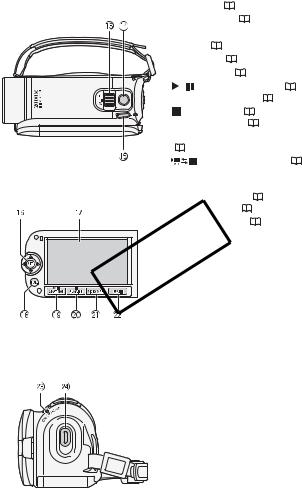
Top view
LCD panel
dA Zoom lever ( |
36) |
|
|
|
fA PHOTO button ( |
|
69) |
|
|
gA POWER button |
|
|
|
|
hA Joystick ( 23) |
|
|
||
jA LCD screen ( |
19) |
|
|
|
kA FUNC. button ( |
24, 86) |
|
||
lA |
/ (play/pause) button ( |
39)/ |
||
START/STOP button ( 34) |
|
|||
qS |
(stop) button ( |
39)/ |
|
|
PLAYLIST button ( |
42) |
|
||
aS VIDEO SNAP (video snapshot) button |
||||
( |
51) |
|
|
|
sS |
(camera/play) button ( |
22) |
||
dS ON/OFF (CHG) (charge) indicator: |
||||
Green – On |
|
|
|
|
Orange – Standby ( |
37) |
|
||
Red – Charging ( |
15) |
|
||
Sf Start/Stop button ( |
34) |
|
||
COPY |
|
|
|
|
Back view
Introduction 13
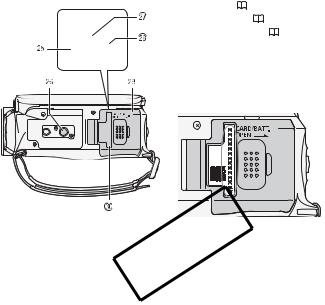
Bottom view |
Sg Battery release latch |
|
|
|
|
|
Sh Tripod socket ( 109) |
|
|
Sj Memory card slot ( |
30) |
|
Sk Battery compartment ( |
15) |
lS Battery compartment cover/Memory card slot cover
Dq Serial number
The serial number label is located on the battery compartment cover.
COPY
14 Introduction
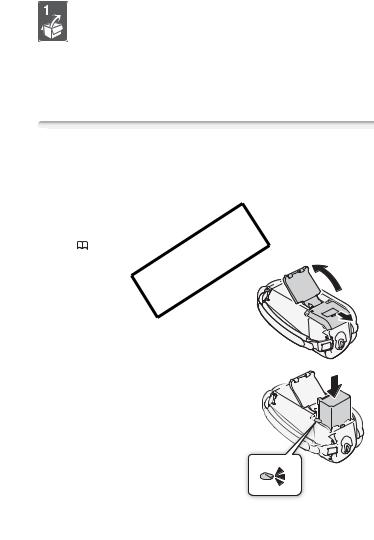
Preparations
This chapter describes basic operations, such as navigating the menus, and first time settings to help you learn more about your camcorder.
Getting Started
Charging the Battery Pack
The camcorder can be powered with a battery pack or directly using the compact power adapter. The first time you use a battery pack, fully charge it and then use the camcorder until the battery pack is completely exhausted. Doing so will ensure that the remaining recording time will be displayed accurately.
For approximate charging times and recording/playback times with a
fully charged battery pack, refer to Charging, Recording and Playback |
||
Times ( 117). |
|
|
1 Slide the battery compartment |
1 |
|
cover away from the lens and open |
||
|
||
it. |
|
|
2 Insert the battery COPYpack all the way into the compartment and press
gently until it clicks.
2
Preparations 15
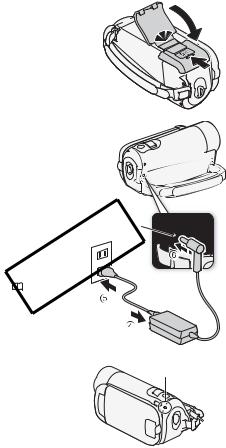
3 Close the cover and slide it toward
|
the lens until you hear a click. |
3 |
|
|
|
4 |
Connect the power cord to the |
|
|
compact power adapter. |
|
5 |
Plug the compact power adapter |
|
|
into a power outlet. |
|
6 |
Connect the compact power |
|
|
adapter to the camcorder’s DC IN |
|
|
terminal. |
|
7 |
Charging will start when the |
|
|
camcorder is turned off. |
|
|
• If the camcorder was on, the green |
|
|
ON/OFF (CHG) indicator will go out |
|
|
when you turn off the camcorder. |
|
|
After a moment, the ON/OFF (CHG) |
|
|
indicator will start flashing in red |
|
|
(battery pack charging). The red |
DC IN |
|
COPY |
|
ON/OFF (CHG) indicator will go out |
terminal |
|
|
when the battery pack is fully |
|
charged. |
|
• If the indicator flashes quickly, refer |
|
to Troubleshooting ( 98). |
|
|
ON/OFF (CHG) |
|
(charge) indicator |
16 Preparations

To remove the battery pack
1 Slide the battery compartment cover away from the lens and open it.
2 Press the battery release latch and pull out the battery pack.
3 Close the cover and slide it toward the lens until you hear a click.
Battery release latch
 IMPORTANT
IMPORTANT
•Turn off the camcorder before connecting or disconnecting the compact power adapter. After pressing POWER to turn off the camcorder,
important data is updated in the memory. Be sure to wait until the green ON/OFF (CHG)COPYindicator goes out.
•We recommend charging the battery pack in temperatures between 10 °C and 30 °C. Outside the temperature range of 0 °C to 40 °C, charging will not start.
•Do not connect to the camcorder’s DC IN terminal or to the compact power adapter any electrical equipment that is not expressly recommended for use with this camcorder.
•To prevent equipment breakdowns and excessive heating, do not connect the supplied compact power adapter to voltage converters for overseas travels or special power sources such as those on aircraft and ships, DC-AC inverters, etc.
 NOTES
NOTES
•The battery pack will be charged only when the camcorder is off.
•If remaining battery time is an issue, you can power the camcorder using the compact power adapter so the battery pack will not be consumed.
•Charged battery packs continue to discharge naturally. Therefore, charge them on the day of use, or the day before, to ensure a full charge.
Preparations 17

•We recommend that you prepare battery packs to last 2 to 3 times longer than you think you might need.
Preparing the Accessories
Fasten the grip belt.
Adjust the grip belt so that you can reach the zoom lever with your index finger, and the Start/Stop button with your thumb.
To remove the grip belt
1 |
Lift the padded handgrip’s flap and detach the strap from the Velcro |
|
pad. Pull the strap to remove it from the camcorder’s front bracket. |
2 |
Pull the other end of the strap through the buckle and remove it |
|
from the camcorder’s rear bracket. |
|
COPY |
18 Preparations

To attach an optional wrist strap
Pass the attaching end of the wrist strap through the rear bracket on the camcorder, thread the wrist strap through the loop and fasten.
Adjusting the Position and Brightness of the LCD Screen
Rotating the LCD Panel
Open the LCD panel 90 degrees.
•You can rotate the panel 90 degrees downward.
•You can rotate the panel 180 degrees toward the lens. Rotating the
LCD panel 180 degrees can be useful when you wish to include yourself in the picture whenCOPYrecording with the self timer.
90° |
Subject can monitor the LCD screen |
 NOTES
NOTES
•About the LCD screen: The screen is produced using extremely high-pre- cision manufacturing techniques, with more than 99.99% of the pixels operating to specification. Less than 0.01% of the pixels may occasionally misfire or appear as black, red, blue or green dots. This has no effect on the recorded image and does not constitute a malfunction.
Preparations 19
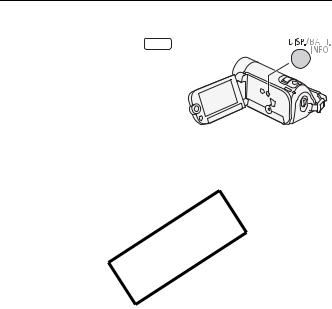
LCD Backlight
When recording in bright places it may be difficult to use the LCD screen. Turn on the LCD backlight to make it brighter.
With the camcorder on, hold DISP. pressed down for more than
2 seconds.
Repeat this action to switch the LCD backlight between off (normal) and on (bright).
 NOTES
NOTES
•The LCD backlight does not affect the brightness of the recordings.
•Using the bright setting will shorten the effective usage time of the battery pack.
•You can further adjust the brightness of the LCD screen with the 
 [LCD Brightness] setting.
[LCD Brightness] setting.
COPY
20 Preparations

Basic Operation of the Camcorder
Operating Modes
Recording
The camcorder offers two basic modes for recording video
and photos: |
|
mode, for beginners or if you just prefer |
|||
not to bother with detailed camcorder settings, and flexible |
|||||
recording ( |
|
) mode, which lets you change the cam- |
|||
corder’s settings to your preference. Press the |
button to |
||||
switch the camcorder to |
mode and press the button |
||||
again to switch back to |
mode. In either mode, you can record |
||||
movies by pressing Start/Stop |
or take photos by pressing PHOTO . |
||||
|
|
|
|
|
|
|
Operating |
|
Onscreen |
Operation |
|
|
mode |
|
icon |
||
|
|
|
|
||
|
|
|
|
|
|
|
|
|
|
Easy recording of movies and photos. |
|
|
|
|
|
|
|
|
|
|
|
Recording of movies and photos while enjoying full |
|
|
|
|
|
access to the menus and advanced functions. |
|
|
About |
|
mode COPY |
|
|
|
|
|
|||
•Only the following buttons/functions are available in this mode.
-Start/Stop for recording movies
-PHOTO for recording photos
- Zoom ( 36)
36)
- Quick Start ( 37)
37)
-  for recording video snapshot scenes (
for recording video snapshot scenes ( 51)
51)
 NOTES
NOTES
• In  mode, menus cannot be accessed but the following settings can be changed in advance.
mode, menus cannot be accessed but the following settings can be changed in advance.
- FUNC. menu: Recording mode of movies.
Preparations 21
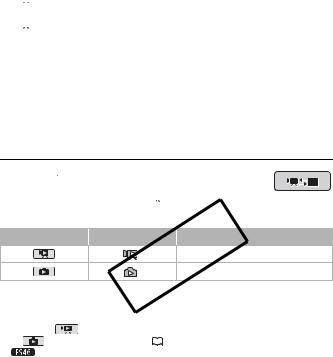
- menu: [Rec Media for Movies]*, [Rec Media for Photos]*, [Widescreen], [Video Snapshot Length].
menu: [Rec Media for Movies]*, [Rec Media for Photos]*, [Widescreen], [Video Snapshot Length].
- menu: [Image Stabilizer]**, [Auto Slow Shutter].
menu: [Image Stabilizer]**, [Auto Slow Shutter].
- ,
,  and
and  menus: All settings.
menus: All settings.
*  only.
only.
**The [  Standard] setting will be used in
Standard] setting will be used in  mode if set to [
mode if set to [  Off] in
Off] in
 mode.
mode.
•Even in  mode, the camcorder can help you with the settings. For example, you can use the Special Scene recording programs (
mode, the camcorder can help you with the settings. For example, you can use the Special Scene recording programs (  47) to set at once all the optimal settings to match special recording conditions.
47) to set at once all the optimal settings to match special recording conditions.
Playback
Press the  (camera/play) button to switch the camcorder between camera (recording) mode and playback mode. You can press
(camera/play) button to switch the camcorder between camera (recording) mode and playback mode. You can press  when the camcorder is off to turn it on directly in playback mode.
when the camcorder is off to turn it on directly in playback mode.
Operating mode |
COPY |
Operation |
|
Onscreen icon |
|
||
|
|
laying back movies. |
|
|
|
Viewing photos. |
|
 NOTES
NOTES
• When switching to playback mode, the [Movies] index screen will be
selected ( |
mode). Use the tabs on the top of the screen to switch |
|||
to |
mode to view photos ( |
|
41). |
|
|
||||
• |
When switching to playback mode, the memory selected for |
|||
playback will be the same currently used for recording movies.
22 Preparations
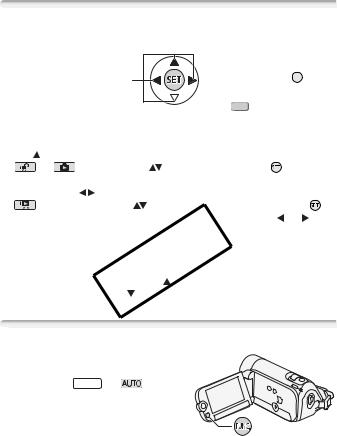
Joystick and Joystick Guide
Use the joystick to operate the camcorder’s menus.
Push the joystick up, down, left or right ( ,
,  ) to select an item or change settings.
) to select an item or change settings.
Press the joystick itself ( 
 ) to save
) to save  the settings or confirm an action. On
the settings or confirm an action. On  menu screens, this is indicated by the
menu screens, this is indicated by the
icon  .
.
The functions that appear in the joystick guide depend on the operating mode. By default, the joystick guide is minimized. Push the joy-
stick ( ) to display it. |
|
|
|
|
||
• |
or |
mode: Select ( |
) a function and press |
to change |
||
|
the setting. With some functions, you will need to make further |
|
||||
|
adjustments ( |
). |
|
|
|
|
• |
mode: First, select ( |
) a “row” of functions; then, press |
to |
|||
|
operate the function in the middle or push the joystick ( |
or |
) to |
|||
|
operate the function on the left or right, respectively. |
|
|
|||
|
|
COPY |
|
|
||
The joystick guide will minimize after 2 seconds. When the joystick |
||||||
guide is minimized, you can still adjust or turn on/off the selected |
||||||
function; you can also maximize ( |
) the joystick guide to select |
|
||||
another function, or hide ( |
) it altogether. |
|
|
|||
Using the Menus |
|
|
|
|
||
Many of the camcorder’s functions can |
|
|
||||
be adjusted from the menus that open |
|
|
||||
after pressing FUNC. . In |
mode, |
|
|
|||
however, menus cannot be accessed and, except in a few cases, most menu settings will return to their default val-
ues.
For details about the available menu options and settings, refer to the appendix Menu Options Lists ( 86).
86).
Preparations 23

Selecting an Option from the FUNC. Menu
The following is an example of selecting a FUNC. menu option in  mode. In playback modes, the operation varies depending on the function selected so refer to the relevant chapter as necessary.
mode. In playback modes, the operation varies depending on the function selected so refer to the relevant chapter as necessary.
1 Press FUNC. .
2 Select ( ) the icon of the function you want to change from the left side column.
) the icon of the function you want to change from the left side column.
Menu items not available will appear grayed out.
3Select ( ) the desired setting from the available options at the bottom bar.
) the desired setting from the available options at the bottom bar.
•The selected option will be highlighted in orange.
•With some settings you will need to make further selections and/or
press  . Follow the additional operation guides that will appear on the screen (such as the
. Follow the additional operation guides that will appear on the screen (such as the  icon, small arrows, etc.).
icon, small arrows, etc.).
4Press FUNC. to saveCOPYthe settings and close the menu.
You can press FUNC. to close the menu at any time.
to open the setup menus.
You can also hold FUNC. pressed down for more than 1 second to open directly the setup menus screen.
3 Select ( ) the tab of the desired menu.
) the tab of the desired menu.
4 Select ( ) the setting you want to change and press
) the setting you want to change and press  .
.
•The orange selection bar indicates the menu setting currently selected. Menu items not available appear grayed out.
•Move ( ) the orange selection bar to the tabs at the top of the screen to select a different menu (step 3).
) the orange selection bar to the tabs at the top of the screen to select a different menu (step 3).
5Select ( ,
,  ) the desired option and press
) the desired option and press  to save the setting.
to save the setting.
24 Preparations
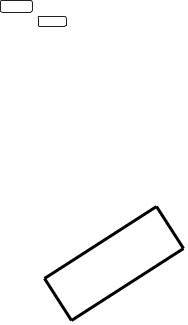
6Press FUNC. .
You can press FUNC. to close the menu at any time.
COPY
Preparations 25
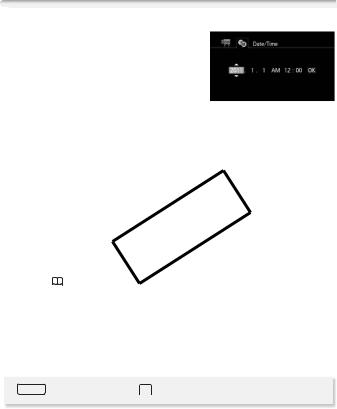
First Time Settings
Setting the Date and Time
You will need to set the date and time of the camcorder before you can start using it. The [Date/Time] screen will appear automatically when the camcorder’s clock is not set.
When the [Date/Time] screen appears, the year will be selected.
1 Change ( ) the year and move (
) the year and move ( ) to the month.
) to the month.
2Change the rest of the fields (month, day, hour and minutes) in the same way.
3Select ( ) [OK] and press
) [OK] and press  to start the clock and close the setup screen.
to start the clock and close the setup screen.
 NOTES
NOTES
•When you do not use the camcorder for about 3 months, the built-in rechargeable lithium battery may discharge completely and the date and time setting may be lost. In such case, recharge the built-in lithium battery ( 112) and set the time zone, date and time again.
•The date appears in a year-month-day format only in the first setup screen. In subsequent screen displays the date and time will appear as day-month-year (for example, [1.Jan.2011 12:00 AM]). You can change the date format and the clock format (12/24 hours) with the 
 [Date Format] setting.
[Date Format] setting.
•You can also change the date and time later on (not during the initial setup). Open the [Date/Time] screen from the setup menus:COPY
FUNC.  [
[  Menu]
Menu] 

 [Date/Time]
[Date/Time]
26 Preparations
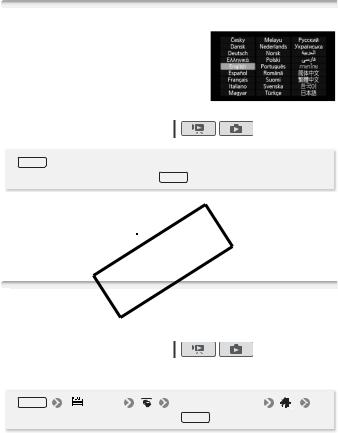
Changing the Language
The default language of the camcorder is English. You can set it to one of 26 other languages.
Operating modes: 

FUNC.  [
[  Menu]
Menu] 

 [Language
[Language  ]
] 
Desired language  FUNC.
FUNC.
 NOTES
NOTES
•The displays  and
and  that appear in some menu screens refer to the name of buttonsCOPYon the camcorder and will not change, regardless of the language selected.
that appear in some menu screens refer to the name of buttonsCOPYon the camcorder and will not change, regardless of the language selected.
Paris.
Operating modes: 

To set the home time zone
FUNC. |
[ Menu] |
[Time Zone/DST] |
* |
Your local time zone**  FUNC.
FUNC.
* When you travel, select ( ) the
) the  icon and select the time zone that matches the local time at your destination.
icon and select the time zone that matches the local time at your destination.
**To adjust for daylight saving time, select the area name marked with a  .
.
Preparations 27
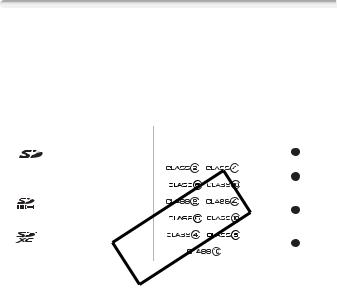
Using a Memory Card
Memory Cards Compatible for Use with the Camcorder
You can use commercially available Secure Digital (SD) cards with this camcorder. However, depending on the memory card, you may not be able to record movies. Refer to the table below.
As of May 2010, the movie recording function has been tested using SD/SDHC memory cards made by Panasonic, Toshiba and SanDisk, and SDXC memory cards made by Panasonic and Toshiba.
Memory card |
Capacity |
SD Speed Class |
|
Recording movies |
|
|
|||||
|
|
|
|
|
|
|
|
64 MB or less |
– |
|
– |
|
|
|
|
|
|
SD |
|
– |
|
* |
|
|
|
|
|||
memory cards |
128 MB or more |
, |
, |
|
|
|
|
|
, |
|
|
|
|
|
|
|
|
|
|
COPY |
, |
|
|
SDHC |
Over 2 GB |
, |
|
||
memory cards |
|
, |
|
|
|
SDXC |
Over 32 GB |
, |
, |
|
|
memory cards |
|
|
|
||
|
|
|
|
||
|
|
|
|
|
|
* Depending on the memory card used, it may not be possible to record movies.
 NOTES
NOTES
•About the SD Speed Class: The SD Speed Class is a standard that indicates the minimum guaranteed data transfer speed of SD/SDHC/ SDXC memory cards. When you buy a new memory card, look for the Speed Class logo on the package.
28 Preparations
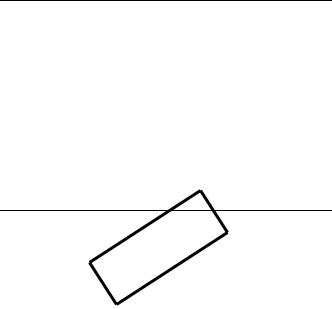
SDXC Memory Cards
As of May 2010, SDXC memory cards have been tested to work under Windows 7. For details on whether your computer's operating system is SDXC-compatible, check with your computer's manufacturer.
 IMPORTANT
IMPORTANT
•If you use an SDXC memory card with a computer OS that is not SDXC-compatible, you may be prompted to format the memory card. In such case, cancel the operation to prevent data loss.
•To use an SDXC memory card with external devices, such as card readers or digital recorders, make sure the external device is SDXCcompatible.
•After repeatedly recording, deleting and editing scenes (fragmented memory), it will take longer to write data on the memory and recording may stop. Save your recordings and initialize the memory.
Eye-Fi cards
This product is not guaranteed to support Eye-Fi card functions (including wireless transfer)COPY. In case of an issue with an Eye-Fi card, please check with the card manufacturer.
Also note that an approval is required to use Eye-Fi cards in many countries or regions. Without approval, use of the card is not permitted. If it is unclear whether the card has been approved for use in the area, please check with the card manufacturer.
Preparations 29
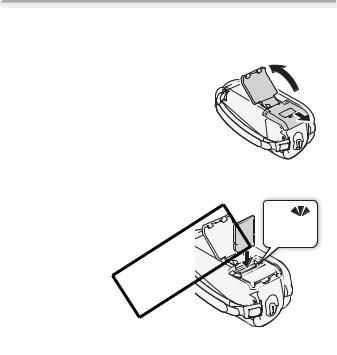
Inserting and Removing a Memory Card
Make sure to initialize ( 31) all memory cards before using them with this camcorder.
31) all memory cards before using them with this camcorder.
1 Turn off the camcorder.
Make sure the ON/OFF (CHG) |
|
indicator is off. |
2 |
2 Slide the memory card slot cover away from the lens and open it.
3 Insert the memory card straight, with the label facing away from the lens, all the way into the memory card slot until it clicks.
4 Close the cover and slide it |
|
toward the lens until you hear a |
3 |
click. |
|
Do not force the cover closed if the |
|
COPY |
|
memory card is not correctly inserted.
To remove the memory card
Push the memory card once to release it. When the memory card springs out, pull it all the way out.
 IMPORTANT
IMPORTANT
•Memory cards have front and back sides that are not interchangeable. Inserting a memory card facing the wrong direction can cause a malfunction of the camcorder. Be sure to insert the memory card as described in step 3.
30 Preparations
